Abstract
Limited-entry fracturing (LEF) technology is a widely used method to realize the simultaneous propagation of multiple fractures in horizontal wells. The key of this technology is to create high perforation friction to maintain the high treatment pressure in the wellbore and realize the uniform fluid entry of multi-fractures; however, high perforation friction cannot be effectively maintained due to the serious perforation erosion effect. Considering that the current laboratory studies mostly used small fluid injection flowrate, low injection pressure, and small proppant dosage, this study has developed a field-scale flow system to investigate the effect of various factors on perforation erosion under real field conditions. The filed-scale flow system uses the real fracturing trucks, proppant, and perforated wellbore, the fluid flow rate through perforation could reach 200 m/s and the injection pressure could reach 105 MPa. The effects of different parameters, such as injection flow rates, proppant concentration, proppant type, proppant size, and carrying fluid viscosity, on the perforation erosion were investigated. The experimental results show that: (1) The perforation friction during erosion goes through two stages, i.e., the roundness erosion stage and the diameter erosion stage. The reduction of perforating friction mainly occurred in the first stage, which was completed after injecting 1 m3 proppant. (2) After erosion, the perforation changes from the original circular shape to a trumpet shape, the inner diameter is much larger than the outer diameter. (3) The more serious perforation erosion is caused by the conditions of high injection flow rate, large proppant size, using ceramic proppant, and low viscosity fluid. The findings of this study can help for a better understanding of perforation erosion during the limited-entry fracturing in the horizontal wells, and also could promote the establishment of a theoretical model of perforation erosion under the field-scale conditions.
1. Introduction
Limited-entry fracturing technology (LEF) is an effective stimulation method to realize the simultaneous propagation of multiple fractures in multi-layer in vertical wells or multi-perforated sections in horizontal wells [1,2,3,4,5,6,7,8]. In this technique, the target zones or sections are perforated with a limited number of perforation clusters via a perforating gun. Then the fracturing fluid flows through these perforations and generates high perforation friction to maintain high treatment pressure in the wellbore, enabling the simultaneous initiation of multiple fractures [9,10,11,12]. Therefore, the key to LEF is the formation of enough high perforation friction to maintain a high treatment pressure in the wellbore. LEF was first applied to the simultaneous fracturing of heterogeneous multi-layers in vertical wells [13]. With the development of unconventional oil and gas resources such as shale oil and gas, the LEF has been widely used during multi-cluster fracturing in horizontal wells, which could effectively stimulate multiple perforated intervals in the horizontal wellbore at the same time [14,15,16]. Due to the serious stress interference and heterogeneity of horizontal intervals, the traditional LEF method cannot achieve simultaneous propagation of multiple fractures [17,18]. Hence, the extremely limited-entry fracturing method (XLEF), creating 2–5 perforations per cluster, is currently designed to maximize the perforation friction and maintain a balanced inflow of multiple fractures [19,20]; however, the downhole camera monitoring shows that the sand-carrying fluid at high flow rates erodes the perforation, resulting in an increase in perforation diameter and a change of perforation shape. Such high perforation friction decreases dramatically due to perforation erosion, which can cause the technique to fail [21]; therefore, it is extremely necessary to study the erosion effect of sand-carrying fluid on perforation under field-scale conditions in horizontal wellbores.
Many scholars have carried out laboratory studies on the effect of sand-carrying fluid on perforation erosion in the wellbore. Crump and Conway (1988) firstly established an indoor circulating flow device to test the perforation friction of sand-laden slurries through a perforated casing. In their experiments, fresh water and sand-carrying fluid are used to measure the perforation friction before and after erosion, respectively; their results show that there are two main mechanisms of perforation erosion: roundness erosion and diameter erosion. During the erosion process, roundness erosion leads to a rapid decrease in perforation friction, while diameter erosion leads to a slow decrease in perforation friction [22]. In their experiments, the injection flow rate is only 0.6 m3/min and the maximum injection pressure is 10.4 MPa. Cramer (1987) calculates the effect of erosion on perforation friction using LEF field data located in the Codell/Niobrara formation, and found that the perforation friction decreases significantly after the injection of proppant, and the original perforation friction can be maintained by increasing the injection flow rate by 50%; meanwhile, based on the field data, he obtained that there is a linear relationship between the hydraulic perforation diameter and the amount of sand through the perforation [13]. According to his results, the hydraulic perforation diameter was expected to increase by 0.00418 inches for every 1000 pounds of proppant injected per perforation. Willingham (1993) studied the friction of clear water and linear gel fluid through perforation based on indoor visual high-pressure wellbore models, and their results show that when the ratio of perforation diameter to the average particle size of the proppant was less than 5, sand bridging occurred. While the ratio was greater than 7, there was a good proppant transport efficiency; therefore, they suggested that sand plugging can be prevented only if the ratio was more than 5. Under these conditions, the perforation friction of linear gel is the same as that of clear water; however, the maximum injection pressure in their experiment was only 1000 psi [23]. El-Rabba (1999) uses low-pressure and high-pressure circulation flow devices to test the perforation coefficient under different fluids; his results show that the change of flow coefficient caused by erosion is a complex function of sand size, sand concentration, perforation diameter, carrier liquid viscosity, injection flow rate, and total pumping time. For example, for the same sand concentration, slurries mixed with larger sand sizes have less flow coefficient loss than slurries mixed with smaller sand sizes, while for the same flow rate, slurries mixed with larger sand sizes have more flow coefficient loss than slurries mixed with smaller sand sizes. In their experiment, the injection flow rate was only 0.18 m3/min [24]. Then, based on the indoor experimental data from Crump and Conway, Romero (2000) fitted the flow coefficient in the erosion process into a linear formula, which was used to determine the change of flow coefficient during the erosion process [25]; his results showed that the discharge coefficient increased from 0.56 to 0.89 with the passage of approximately 2000 lbm of proppant through the perforation. Long et al. (2017) developed a semi-empirical model of perforation erosion, and the model parameters were obtained from the indoor experimental data of Crump and Conway (1987); his model shows that the perforation diameter and perforation coefficient are proportional to the proppant concentration and the square of the perforation velocity [26]. Loehken et al., (2020) et al. developed a new large indoor high-pressure flow device to detect the influence of backpressure and perforation erosion on the flow coefficient; their results show that erosion will lead to an increase in the perforation coefficient, and this increase is even higher at a high cavitation number, indicating that the effect of erosion also depends on pressure conditions [27]; however, its experimental pressure condition can only reach 2000 psi, so it cannot simulate the real field conditions, which limited its application [28].
In the above research, scholars only explore the influence of perforation erosion on the perforation friction from small-scale laboratory experiments; however, in the laboratory experiments, the experimental injection flow rate and injection pressure are relatively small, which is different from the conditions of “large flow rate and high pressure” in the actual fracturing process of horizontal wells. According to the photo results of the downhole camera, the perforation erosion phenomenon in the actual fracturing process is much more serious than the laboratory experiments, which limits the application of the existing laboratory results; therefore, it is very necessary to establish a field-scale experiment to test the perforation erosion under the real flow conditions of large flowrate, high injection pressure and large proppant dosage, et al.
In this paper, a field-scale flow system is developed, which uses real fracturing trucks, water tank trucks, sand trucks, blender trucks, instrument trucks, high-pressure pipelines, and the perforated wellbore. The highest flow rate through the perforation can reach 200 m/s, and the injection pressure can reach 105 MPa. Based on this field-scale flow system, a series of experiments are carried out to investigate the erosion effect of sand carrying fluid on single perforation in a horizontal wellbore under different working conditions. The changing pattern of the perforation shape and the perforation friction after erosion are revealed under real field conditions. The effects of different parameters, such as injection flow rates, proppant concentration, proppant type, proppant particle size, and carrying fluid viscosity, on the perforation erosion were investigated. The experimental results can provide new insight into the perforation erosion caused by sand-carrying fluid under the field-scale conditions, and can also provide the original data for the establishment of the perforation erosion model under the field-scale condition.
2. Materials and methods
2.1. Limited-Entry Perforation Fracturing (LEF)
Limited-entry fracturing is a widely used and economical method for the development of unconventional oil/gas resources [22]. High perforation friction can be generated by limiting the number or diameter of perforations. High perforating friction creates high backpressure in the wellbore, balancing the difference in the propagation resistance among multiple fractures. The difference is mainly caused by two factors: rock inhomogeneity (including natural fractures and formation physical properties); stress interference effects due to the mechanical interaction among fractures
The perforation friction can be calculated based on Bernoulli’s equation [22]:
where ΔPf is the perforation friction, psi; Q is the injection flow rate, bbl/min; ρ is the fluid density, lb./gal; Cd is the perforation coefficient, 0.56–0.90 during the fracturing process; N is the number of perforations, 3–16 perforations per cluster for the common completions in the wells; D is the perforation diameter, in, usually 0.25~0.40 inches.
The key to the limited-entry fracturing method (LEF) is providing a high enough perforation friction. According to the above equation, the perforation friction can be enlarged by limiting the number or decreasing the diameter of perforations, or increasing the injection flow rate, thus increasing the treatment pressure and creating a more uniform fluid distribution among multiple fractures. As shown in Figure 1, the injection pressure can reach 3800 Psi with the increase in fluid injection rate (Step 1). Zone B will be firstly fractured due to its lowest fracture propagation resistance (Step 2). When fluid flows through the perforations of Zone B at a higher injection rate, the injection pressure can reach 4000 Psi and Zone C began to generate a fracture (Step 3). When fluid flows through the perforations of Zone C, the injection pressure can reach 4200 Psi and Zone A began to generate a fracture (Step 4). At last, all the zones can be stimulated uniformly (Step 5).
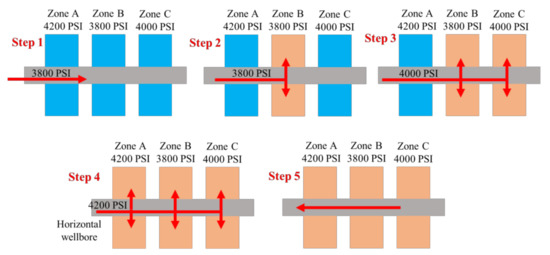
Figure 1.
Mechanism of LEF during horizontal well fracturing.
2.2. Real Field-Scale Perforation Erosion Evaluation System
The field-scale flow experiment was designed to investigate the effect of sand slurry fluid on perforation erosion under real field conditions (high flow rate, high pressure, and large proppant dosage). The changes in injection pressure and perforation diameter were recorded in real-time. As shown in Figure 2, the system includes fracturing trucks, water tank trucks, sand trucks, blender trucks, instrument trucks, high-pressure pipelines, and the perforated wellbore. The function of the fracturing truck group, which is connected in parallel with several fracturing trucks, is to provide high pressure and a large flow rate to erode the perforations. The maximum fluid flow rate through the perforation can reach 200 m/s and the maximum injection pressure can reach 105 MPa. The water tank trucks store and supply fracturing base fluid (such as water) for the fracturing trucks. A single tank truck can store up to 30 m3 of liquid and can be replenished at any time due to the maneuverability of the vehicle. The sand truck is mainly used to store and provide proppant, and each tank could store 20 m3 proppant. The blender truck could automatically track the fracturing process through the automatic control system and realize the automatic control of the parameters such as fluid additives, proppant concentration, and proppant pump pressure. It can mix, stir, and transport the proppant. The instrument truck is applied for controlling and monitoring the pressure, flow rate, fracturing fluid density, water horse-power, and other parameters in real-time, and make real-time feedback adjustments according to the preset parameters to ensure the safety of the experiments. The high-pressure pipeline is the main injection channel of fracturing fluid, and its maximum bear pressure can reach 110.0 MPa. In addition, there is a specially designed pool for storing and dredging the fracturing fluid. As shown in Figure 3, the perforated wellbores are made by the on-site fracturing casing but just have a length of one meter. Its steel grade is TP125V and its internal pressure resistance is 90.70 MPa. The outer diameter of the wellbores is 139.7 mm, the wall thickness is 10.54 mm. One end of the casing is threaded and connected to the high-pressure pipelines, and the other end is plugged. A perforation with a diameter of 10 mm was machined in the middle of the steel casing.
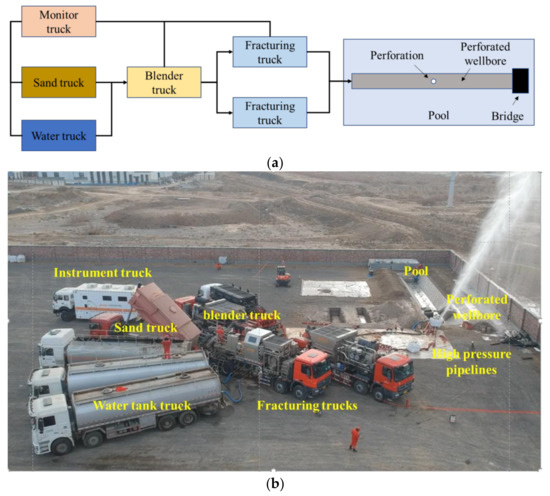
Figure 2.
Real field-scale perforation erosion evaluation system (a). Schematic diagram, (b). Physical model.
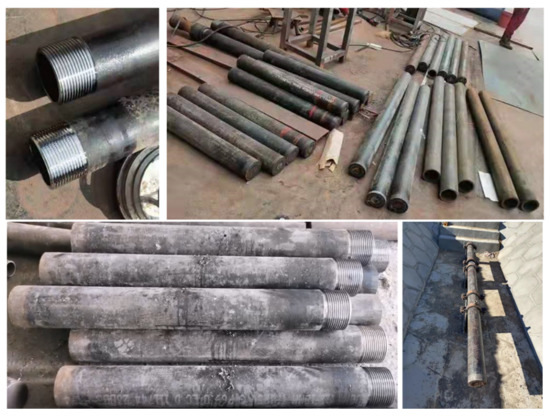
Figure 3.
Photos of steel casing processing.
2.3. Experimental Methods and Schemes
Perforating erosion is a complex fluid–solid flow process during hydraulic fracturing. According to Crump and Conway (1968) [22], the main cause of perforation erosion is the abrasion of the proppant due to its moving inertia; therefore, perforating erosion process is directly related to fluid flow rate, slurry viscosity, proppant size, proppant concentration, and proppant dosage. Generally, the field injection rate of single perforation is 0.6–0.9 m3/min; the proppant sizes are 20/40 and 40/70 mesh, and the proppant types are quartz and ceramic sand with concentrations ranging from 60 kg/m3 to 300 kg/m3. In this work, ten field experiments (Test 1–10) were designed to investigate the perforation erosion patterns under various conditions. Test 1 adopts the low sand concentration (60 kg/m3), which is mainly used to study the influence of flowrate as a reference test. Test 2 uses the dynamic step-addition method (proppant concentration increased from 60 kg/m3 to 300 kg/m3) and is designed to determine the effect of the step sand addition method on perforation erosion. Test 3 adopts a high injection flow rate (0.9 m3/min) and was designed to investigate the effect of step sand addition on perforation erosion at a higher injection flow rate. Test 4 simulates the extreme limited-entry perforation completion method (XLE), which maintains a high injection pressure during the whole fracturing process by increasing the flow rate from 0.9 m3/min to 1.3 m3/min. Test 5 adopts the high-viscosity fracturing fluid, which is to study the effect of the fluid viscosity on perforation erosion. Test 6 adopts 20/40 mesh Quartz sand proppant, which is designed to study the effect of proppant size; Test 7 adopts the 40/70 mesh ceramics, which is designed to study the effect of proppant type. Test 8–11 adopts different sand concentrations to explore the influence of sand concentration on perforation erosion under the same cumulative amount of proppant.
2.4. Experimental Procedure
During field experiments, the experimental area should be separated from the operation area to avoid risks caused by high pressure and high flow rate conditions. Meanwhile, the experiments shall be carried out in strict accordance with health, safety, and environmental (HSE) standards, and the specific steps of the experiment shall be carried out as follows:
- Step 1. Place and fix the perforated wellbore into the pool, and connect it to the high-pressure pipelines.
- Step 2. Prepare the fracturing fluid and proppant separately and place them in the water tank truck and sand truck.
- Step 3. Assemble the equipment through pipelines, and respectively conduct the process of pressure test, sealing test, and safety test of the system.
- Step 4. Carry out each test according to Table 1. First, inject the pure water to measure the perforation friction under the no-proppant condition. Secondly, inject a certain concentration of proppant in Table 1. Photograph the perforation wellbore and measure its diameter when a certain amount of sand was injected. Finally, when the total amount of sand injected is satisfied, stop the injection pump. Parameters such as injection rate, injection pressure, and proppant concentration were recorded throughout the experiment.
 Table 1. Experimental schemes.
Table 1. Experimental schemes. - Step 5. Remove the perforated wellbore after testing, change the new perforated wellbore to start the next test, and repeat Steps 1–4 until all tests are finished.
- Step 6. All casings will be cut from the inside section at the end, and the perforations will be scanned by a 3D scanner to obtain perforation shapes, and perforation diameters will be measured both inside and outside the casing.
3. Results and Discussion
3.1. Results of Perforation Friction after Erosion
Figure 4 shows the injection curves vs. time in Tests 1–10. In the injection curves, injection pressure, injection flow rate, and sand percent are recorded in detail. Since the outlet of the perforation is at the atmospheric pressure, the injection pressure during the flow process can be approximately treated as the perforation friction. As mentioned above, the perforation erosion state was recorded by stopping the pump. As shown in Table 1, Tests 1, 8, 9, and 10 had constant injection flow rates and sand concentration. Test 4 simulates the extreme limited-entry fracturing method, which continuously increases the flow rate to maintain the high perforation friction. Other tests used the step-increment sand concentration injection to simulate a realistic pumping sequence in the field operation.
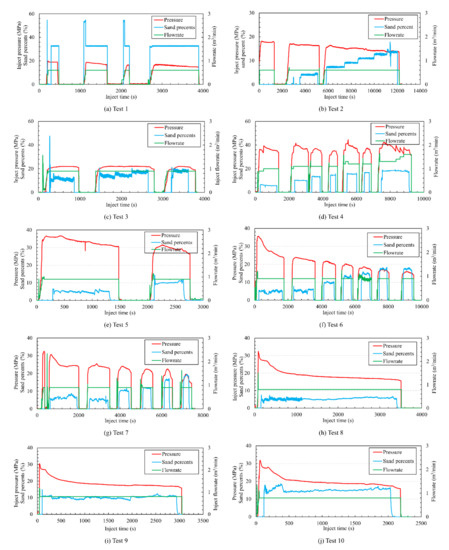
Figure 4.
Injection curves vs. time in Tests 1–10 (a). Test 1; (b). Test 2; (c). Test 3; (d). Test 4; (e). Test 5; (f). Test 6; (g). Test 7; (h). Test 8; (i). Test 9; (j). Test 10.
As shown in Figure 4, the perforation friction decreased due to the effect of perforation erosion in all tests. The downward trend is characterized by a rapid decline stage in the erosion stage and a slow decline stage in the erosion stage. Crump and Conway (1968) firstly pointed out that the first process of rapid erosion is called roundness erosion, which mainly induces the change of perforation shape and quickly changes the perforation coefficient [22]. The second erosion process is called the diameter erosion stage, which slowly increases the perforation diameter. In our experiment, the roundness erosion stage was not obvious at low injection flow rates and low sand concentrations (Tests 1 and 2), but strong at high injection flow rates and high sand concentrations (Tests 6–10). The reason is the kinetic energy of the proppant is lower when using a lower flow rate. The reduction of perforation friction also could represent the effect of perforation erosion. Specifically, the perforating friction in Test 1 decreased by 4.0 MPa after injecting 4.3 m3 proppant with a flow rate of 0.6 m3/min and a sand concentration of 60 kg/m3. the perforation friction of Test 2 decreased by 4.4 MPa after injecting 6 m3 proppant using the step-increment concentration from 60–300 kg/m3. In Test 3, the perforation friction decreased by 13.4 MPa with a high injection rate of 0.9 m3/min, which is more vulnerable to perforation erosion. In Test 4, the extreme limited-entry fracturing method was simulated by increasing the injection rate from 0.9 m3/min to 1.3 m3/min, thus the high perforation friction can be maintained. In Test 5, with a high viscosity injection fluid, the perforating friction decreased by 7.7 MPa. In Test 6, a larger reduction of perforating friction (21.4 MPa) occurred with a larger proppant size (20/40 mesh quartz). In Test 7, a little greater reduction of perforating friction (14.6 MPa) was obtained when using quartz sand proppant. In Tests 6 and 7, as the sand concentration increases, the proppant has a greater chance of colliding with the perforation hole, the erosion causes the perforation diameter to increase and the edges of the perforation holes to be more rounded, making it easier for the proppant to pass through the perforations and the perforation friction pressure to decrease. Compared with Tests 8–10, the reduction of perforating friction was almost the same at different proppant concentrations, meaning that the proppant concentration has a negligible effect on the reduction of perforating friction. In Tests 9 and 10, the injection pressure decreases fastest in the early stages when maintaining a relatively constant sand concentration, and the injection pressure remains constant in the later stage, which means that the erosion of proppant on the perforations has been decreased due to the increased perforation diameter in the later stage.
3.2. Results of Perforation Shapes after Erosion
After the experiments, all the perforated casings were cut, and the inner and outer diameters of the perforation were measured. Figure 5 shows the internal perforation shapes in all the tests, and the internal shape was marked with yellow dotted lines.
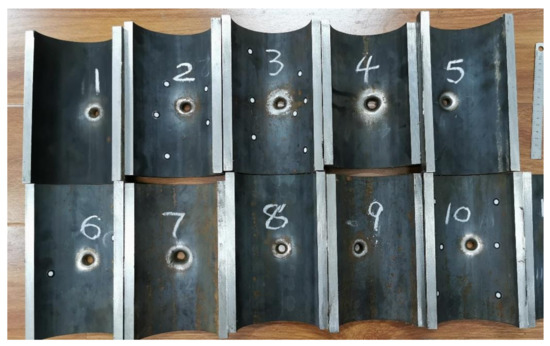
Figure 5.
Internal perforation shapes in tests 1–10 after erosion.
Figure 6 shows the internal and external shape of the erosion perforation in Test 4. The erosion degree of the internal part is much greater than that of the external part. The perforation shape has changed from a regular circular hole to a trumpet shape hole. The formation of the trumpet shape is affected by the flow line from the sand-carrying fluid through the perforation hole, which firstly erodes the internal part of the perforation hole; therefore, the process of perforation erosion can be expressed as eroding the internal part of the perforation; forming a trumpet perforation; eroding the external part of the perforation; expanding the outer diameter of the perforation.
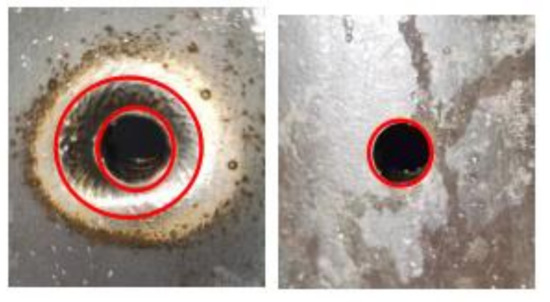
Figure 6.
Perforation shape after erosion (left, internal part; right, external part).
Table 2 gives the measured inner diameter of the perforation , the outer diameter of the perforation , the erosion volume of the perforation , the perforation erosion thickness
, and the reduction value of the perforation friction ∆P, respectively. Comparing Test 1 and Test 2, it shows that the erosion effect increases with proppant dosage,
increases from 4 mm to 4.4 mm, and the outside diameter
has no obvious difference. Comparing Test 2 and Test 3, it shows that ∆P increases from 4.4 MPa to 13.4 MPa at high injection flowrate, the inner diameter
increases from 18.54 mm to 21.54 mm, while the outer diameter
has a small difference of 0.08 mm. In Test 4, the perforation friction remains at a high value by increasing the flow rate from 0.9 m3/min to 1.3 m3/min during the erosion process, the inner diameter of the perforation has increased by 24 mm, and the outer diameter of the perforation hole increased by 2.40 mm. In Test 5, when using high-viscosity fluid, the internal diameter of the perforation increased by 17.14 mm even though only 2 m3 proppant was injected. Comparing Test 3 with Test 6, it can be found that 20/40 mesh quartz sand induces more serious erosion than that of 40/70 mesh quartz sand. Under the same sand injection conditions, the inner diameter of perforation increased by 23.7 mm and the perforation friction decreased by 21.4 MPa. Comparing Test 3 and Test 7, ceramic type proppant induces a greater perforation erosion than that of the quartz sand proppant. Under the same injection condition, the ceramics proppant induces a greater perforation friction reduction and a greater internal perforation diameter increment. Tests 8–10 kept the same proppant dosage of 5 m3, the perforation friction reduction values have no obvious difference, ranging from 11.4 MPa to12.0 MPa; the inner perforation diameters have a small difference, ranging from 17.4 mm to 18.02 mm. It can be concluded that the proppant concentration has a negligible effect on perforation erosion under high-speed injection conditions.

Table 2.
Measurement results of perforation erosion parameters for tests 1–10.
3.3. The Influence Parameters of Perforation Erosion
3.3.1. The Effect of Injection Flowrate
Figure 7 shows the curves of perforation friction vs. time under different injection flowrates of 0.6 m3/min in Test 1 and 0.8 m3/min in Test 8, respectively. Tests 1 and 8 have the same other parameters, such as proppant type, proppant concentration, and fluid type. It demonstrates that the large injection flow rate induces high initial perforation friction. The perforation erosion degree increases with the fluid injection flow rate. At the low injection flowrate (0.6 m3/min), the perforation friction reduction is limited, the perforation friction remains constant and the perforation erosion no longer occurs after injecting a certain dosage of proppant; under high injection flowrates, the perforation friction reduction is greater and the perforation erosion process will continue until reaching a larger proppant dosage.
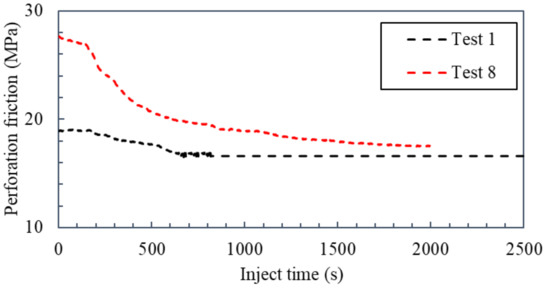
Figure 7.
Perforation friction vs injection time at different injection flowrates (1 m3 40/70 mesh quartz sand).
3.3.2. The Effect of Proppant Concentration
Figure 8 shows the curves of perforation friction vs. injection time at different proppant concentrations. PF denotes perforation friction, and PC denotes proppant concentration; it demonstrates that there is a strong perforation erosion stage before 500 s and a weak perforation erosion stage after 500 s for different proppant concentrations. The perforation friction reductions have almost no difference after injecting 5 m3 proppant for various proppant concentrations, which means the proppant concentration has a negligible effect on perforation erosion. The perforation friction reductions at the proppant concentrations of 60 kg/m3, 180 kg/m3, and 240 kg/m3, are respectively 10.31, 10.60, and 11.14 MPa; however, according to Long et al., 2017, proppant concentration has a strong effect on perforation erosion. The discrepancy lies in that the proppant concentration in Long’s work is below 10 kg/m3. The perforation erosion degree increases with proppant concentration of a low level. While in this work, the proppant concentration is beyond 60 kg/m3, which means the proppant concentration of a high level does not affect the perforation erosion degree; moreover, during on-site hydraulic fracturing, the proppant concentration is typically between 60 and 360 kg/m3, and thus field engineers cannot lower the perforation erosion degree by decreasing the proppant concentration.
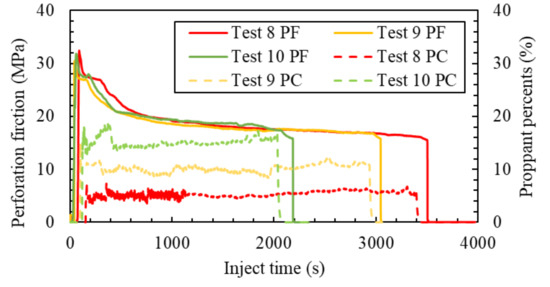
Figure 8.
Perforation friction vs. injection time at different proppant concentrations (PF denotes perforation friction, PC denotes proppant concentration).
3.3.3. The Effect of Fluid Viscosity
Figure 9 shows the curves of perforation friction vs. time at different fluid viscosities. The perforation erosion rate of low fluid viscosity is higher than that of high fluid viscosity. This is because high viscosity fluid can effectively disperse the proppant and the proppant can be transported uniformly, which effectively reduced the contact area between the proppant and the perforation; moreover, perforation friction can be maintained at a high level when using high viscosity fluid due to the high fluid flow resistance.
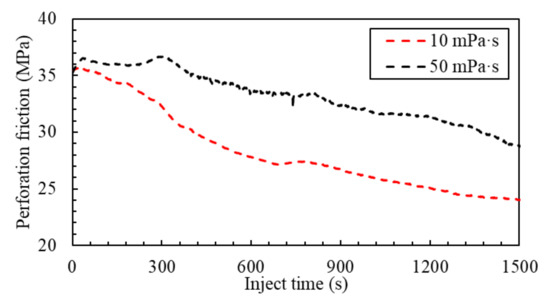
Figure 9.
Perforation friction vs. injection time at different fluid viscosities (proppant dosage of 6 m3).
3.3.4. The Effect of Proppant Size
Figure 10 demonstrates the effect of proppant size on perforation erosion. The proppant of a large size (20/40 mesh) induces greater perforation erosion than that induced by the small size proppant (40/70 mesh). This phenomenon is more obvious at the early erosion stage; however, perforation erosion rates of both large and small size proppant decrease gradually and nearly reach the same level after injecting 4 m3 proppant. The reason is that large size proppant has a larger contact area with a perforation surface. After eroding the perforation to a certain level, the proppant dosage has no obvious effect on perforation erosion.
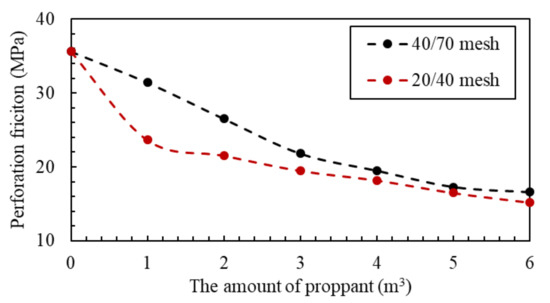
Figure 10.
Perforation friction vs. proppant dosage at different proppant sizes.
3.3.5. The Effect of Proppant Type
Figure 11 shows the curves of perforation friction vs. proppant dosage at different proppant types. The ceramic proppant induces a greater perforation erosion than that of the quartz and proppant. The reason is ceramic proppant has higher strength and higher hardness, which accelerates the erosion speed. While quartz proppant is not strong enough and breaks when contacting steel casing; moreover, perforation erosion quickly reaches a balance after injecting 1 m3 ceramic proppant while perforation erosion slowly reaches a balance after injecting 4 m3 quartz proppant. It can be concluded that proppant type is one of the key factors that determine the final erosion state.
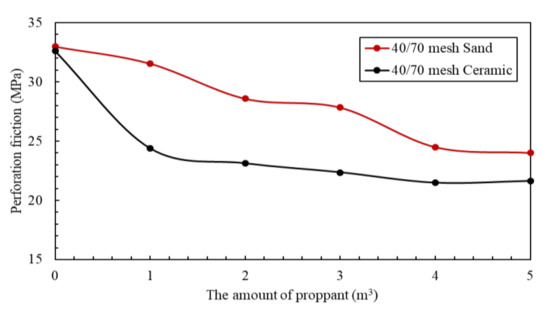
Figure 11.
Perforation friction vs. proppant dosage at different proppant types.
3.4. The Perforation Erosion Mechanism Induced by Proppant
Through the analysis of the above experimental results, two important erosion stages were further obtained as shown in Figure 12.
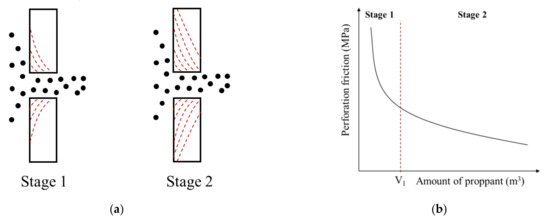
Figure 12.
Mechanism of perforation erosion ((a) two stages during proppant erosion; (b) perforation friction curves vs. amount of proppant)).
- Stage 1: Roundness erosion stage. As shown in Figure 12a, the proppant quickly flushes the inside part of the perforation, eroding the perforation from a cylindrical shape to a trumpet shape. Perforation friction is greatly reduced when fluid passes through the trumpet-shaped perforation.
- Stage 2: Diameter erosion stage. As shown in Figure 12b, when the erosion depth exceeds the thickness of the casing, the external part of the perforation began to be eroded and the external diameter of the perforation increased gradually. While the trumpet shape of the perforation remained all the way. Because of the small enlargement rate of the external diameter, the perforation friction decreases at a low speed.
Influencing factors:
- Proppant size: Affecting the first stage; large proppant size accelerates the erosion rate of stage 1 but does not affect the erosion rate of stage 2.
- Proppant type: Both influencing Stages 1 and 2; the ceramic proppant induces more serious perforation erosion than that induced by the quartz sand proppant
- Proppant concentration: Having a negligible effect on perforation erosion; with the same dosage of proppant, perforation friction reduction was nearly at the same level for different proppant concentrations.
- Fluid viscosity: Weakening Stages 1 and 2 when using high viscosity fluid; high viscosity fluid induces a smaller perforation erosion level and maintains high perforation friction.
- Injection rate: Influencing Stages 1 and 2; no obvious perforation erosion occurs at a low injection rate, while strong perforation erosion is caused at a high injection rate.
In this paper, the effects of proppant erosion on single perforation holes have been investigated during the fracturing process; however, in contrast to the real fracturing process in the subsurface, there are often multiple perforation clusters in a single stimulation stage, and it is important to distinguish the proppant erosion laws and proppant distribution processes on multiple perforation clusters. Therefore, future work should take into account the effect of proppant erosion on the multiple clusters of perforations in the horizontal wells. Meanwhile, collecting the corresponding fluid ratios and proppant ratios of each cluster will help analyze the dynamic distribution of proppant in multiple clusters in horizontal wells. In addition, the erosion laws under different wellbore slopes, perforation phase angles and non-uniform perforation sizes should also be fully considered in the further work, which will be closer to the real situation during the fracturing process.
4. Summary and Conclusions
In this paper, A field-scale experimental study was conducted to investigate the effect of various factors on perforation erosion in one horizontal wellbore. Under the real fracturing conditions of “large flowrate, high injection pressure, and large proppant dosage”, the perforation friction and perforation diameter change after erosion were collected. Factors such as proppant type, proppant size, proppant concentration, fluid viscosity, and injection rate were further analyzed. The main conclusions are as follows:
- Perforation erosion goes through two stages: the roundness erosion stage, where pressure performs a rapid decline, and the diameter erosion stage, where pressure performs a slow decline. Perforation friction reduction occurs in the first stage, which nearly reaches the final stage after injecting 1 m3 proppant.
- The perforation shape changes from the original circular shape to a trumpet shape after erosion, whose inner diameter is much larger than the outer diameter.
- Increasing injection flow rate, proppant particle size, proppant concentration, and adopting the ceramic proppant and low viscosity fluid can increase the perforation erosion degree.
- When using the extreme limited-entry completion method, the perforation friction can remain at a high level by continuously increasing the injection rate; however, the perforation diameter will still increase greatly after erosion.
- To reduce the degree of perforation erosion, the high-viscosity carrier fluid and high-mesh quartz sand proppant are recommended during on-site field operations.
Author Contributions
B.W. (Baocheng Wu): Conceptualization, Methodology, Writing—Original Draft, Writing—Review and Editing. Investigation. F.Z.: Resources, Supervision, Funding acquisition. M.W.: Investigation, Data Curation. Z.L.: Investigation, English and Grammar. M.L.: Methodology, Analysis, Writing—Review and Editing. B.W. (Bo Wang): Visualization, Writing—Review and Editing. X.G.: Investigation, Data Curation; J.Z.: English and Grammar, Investigation. All authors have read and agreed to the published version of the manuscript.
Funding
This work was sponsored by Research Foundation of China University of Petroleum-Beijing at Karamay (No. XQZX20210001), Natural Science Foundation of Xinjiang Uygur Autonomous Region (2022D01B80), and National Natural Science Foundation of China (No. 52104011 and No.52174045).
Conflicts of Interest
The authors declare that they have no known competing financial interests or personal relationships that could have appeared to influence the work reported in this paper.
References
- Li, Y.; Deng, J.; Liu, W.; Yan, W.; Feng, Y.; Cao, W.; Wang, P.; Hou, Y. Numerical simulation of limited-entry multi-cluster fracturing in horizontal well. J. Pet. Sci. Eng. 2017, 152, 443–455. [Google Scholar] [CrossRef]
- Zhang, L.; Zhou, F.; Zhang, S.; Wang, J.; Wang, Y. Evaluation of permeability damage caused by drilling and fracturing fluids in tight low permeability sandstone reservoirs. J. Pet. Sci. Eng. 2019, 175, 1122–1135. [Google Scholar] [CrossRef]
- Li, M.; Zhou, F.; Yuan, L.; Chen, L.; Hu, X.; Huang, G.; Han, S. Numerical modeling of multiple fractures competition propagation in the heterogeneous layered formation. Energy Rep. 2021, 7, 3737–3749. [Google Scholar] [CrossRef]
- Li, M.; Lv, W.; Liu, J.; Sun, Z.; Zhou, F.; Wang, B. Effect of perforation friction on 3D In-stage multiple fracture propagation: A numerical study. Eng. Fract. Mech. 2022, 267, 108415. [Google Scholar] [CrossRef]
- Li, M.H.; Zhou, F.J.; Liu, J.J.; Yuan, L.S.; Huang, G.P.; Wang, B. Quantitative investigation of multi-fracture morphology during TPDF through true tri-axial fracturing experiments and CT scanning. Pet. Sci. 2022, in press. [Google Scholar] [CrossRef]
- Li, M.; Zhou, F.; Sun, Z.; Dong, E.; Yuan, L.; Wang, B. Experimental study on plugging performance and diverted fracture geometry during different temporary plugging and diverting fracturing in Jimusar shale. J. Pet. Sci. Eng. 2022, 215, 110580. [Google Scholar] [CrossRef]
- Li, M.H.; Zhou, F.J.; Wang, B.; Hu, X.D.; Wang, D.B.; Zhuang, X.Y.; Han, S.B.; Huang, G.P. Numerical simulation on the multiple planar fracture propagation with perforation plugging in horizontal wells. Pet. Sci. 2022, in press. [Google Scholar] [CrossRef]
- Li, M.; Zhou, F. Multi-fracture initiation sequence and breakdown pressure in horizontal wells during TDPF: A visualization experimental investigation based on PMMA. J. Petrol. Sci. Eng. 2022, 215, 110645. [Google Scholar] [CrossRef]
- Liu, X.; Zhang, W.; Qu, Z.; Guo, T.; Sun, Y.; Rabiei, M.; Cao, Q. Feasibility evaluation of hydraulic fracturing in hydrate-bearing sediments based on analytic hierarchy process-entropy method (AHP-EM). J. Nat. Gas Sci. Eng. 2020, 81, 103434. [Google Scholar] [CrossRef]
- Guo, T.; Zhang, S.; Wang, L.; Sui, W.; Wen, H. Optimization of proppant size for frac-pack completion based on a new equipment. J. Pet. Sci. Eng. 2012, 96, 1–9. [Google Scholar] [CrossRef]
- Liu, Z.; Reynolds, A.C. A sequential-quadratic-programming-filter algorithm with a modified stochastic gradient for robust life-cycle optimization problems with nonlinear state constraints. SPE J. 2020, 25, 1938–1963. [Google Scholar] [CrossRef]
- Thanh, H.V.; Sugai, Y.; Nguele, R.; Sasaki, K. Integrated workflow in 3D geological model construction for evaluation of CO2 storage capacity of a fractured basement reservoir in Cuu Long Basin, Vietnam. Int. J. Greenh. Gas Control 2019, 90, 102826. [Google Scholar] [CrossRef]
- Cramer, D.D. The application of limited-entry techniques in massive hydraulic fracturing treatments. In Proceedings of the SPE Production Operations Symposium, OnePetro, Oklahoma City, OK, USA, 8 March 1987. [Google Scholar] [CrossRef]
- Cramer, D.; Friehauf, K.; Roberts, G.; Whittaker, J. Integrating DAS, treatment pressure analysis and video-based perforation imaging to evaluate limited entry treatment effectiveness. In Proceedings of the SPE Hydraulic Fracturing Technology Conference and Exhibition. OnePetro, Oklahoma City, OK, USA, 9–10 April 2019. [Google Scholar] [CrossRef]
- Liu, Z.; Reynolds, A. Robust Multiobjective Nonlinear Constrained Optimization with Ensemble Stochastic Gradient Sequential Quadratic Programming-Filter Algorithm. SPE J. 2021, 26, 1964–1979. [Google Scholar] [CrossRef]
- Liu, Z.; Reynolds, A.C. Gradient-Enhanced Support Vector Regression for Robust Life-Cycle Production Optimization with Nonlinear-State Constraints. SPE J. 2021, 26, 1590–1613. [Google Scholar] [CrossRef]
- Wang, B.; Zhou, F.; Zou, Y.; Liang, T.; Wang, D.; Hu, J.; Gao, L. Effects of previously created fracture on the initiation and growth of subsequent fracture during TPMSF. Eng. Fract. Mech. 2018, 200, 312–326. [Google Scholar] [CrossRef]
- Wang, B.; Zhou, F.; Zou, Y.; Liang, T.; Wang, D.; Xue, Y.; Gao, L. Quantitative investigation of fracture interaction by evaluating fracture curvature during temporarily plugging staged fracturing. J. Pet. Sci. Eng. 2019, 172, 559–571. [Google Scholar] [CrossRef]
- Weddle, P.; Griffin, L.; Pearson, C.M. Mining the Bakken II–Pushing the envelope with extreme limited entry perforating. In Proceedings of the SPE Hydraulic Fracturing Technology Conference and Exhibition, OnePetro, Woodlands, TX, USA, 23–25 January 2018. [Google Scholar] [CrossRef]
- Somanchi, K.; Brewer, J.; Reynolds, A. Extreme limited-entry design improves distribution efficiency in plug-and-perforate completions: Insights from fiber-optic diagnostics. SPE Drill. Completion 2018, 33, 298–306. [Google Scholar] [CrossRef]
- Barree, R.D. Potential Issues with Extreme Limited Entry in Horizontal Wells. In Proceedings of the Unconventional Resources Technology Conference (URTEC), Virtual, 20–22 July 2020; pp. 713–733. [Google Scholar] [CrossRef]
- Crump, J.B.; Conway, W.M. Effects of perforation-entry friction on bottomhole treating analysis. J. Pet. Technol. 1988, 40, 1041–1048. [Google Scholar] [CrossRef]
- Willingham, J.D.; Tan, H.C.; Norman, L.R. Perforation friction pressure of fracturing fluid slurries. In Proceedings of the Low Permeability Reservoirs Symposium, OnePetro, Oklahoma City, OK, USA, 21–23 March 1993. [Google Scholar] [CrossRef]
- El-Rabba, A.M.; Shah, S.N.; Lord, D.L. New perforation pressure-loss correlations for limited-entry fracturing treatments. SPE Prod. Facil. 1999, 14, 63–71. [Google Scholar] [CrossRef]
- Romero, J.; Mack, M.G.; Elbel, J.L. Theoretical model and numerical investigation of near-wellbore effects in hydraulic fracturing. SPE Pro. Fac. 2000, 15, 76–82. [Google Scholar] [CrossRef]
- Long, G.; Xu, G. The effects of perforation erosion on practical hydraulic-fracturing applications. SPE J. 2017, 22, 645–659. [Google Scholar] [CrossRef]
- Loehken, J.; Yosefnejad, D.; Fricke, B. Experimental investigation on parameters affecting the Coefficient of Discharge of a perforation hole in hydraulic fracturing treatments. In Proceedings of the SPE Hydraulic Fracturing Technology Conference and Exhibition, OnePetro, Woodlands, TX, USA, 4–6 February 2020. [Google Scholar] [CrossRef]
- Zhang, F.; Wang, X.; Tang, M.; Du, X.; Xu, C.; Tang, J.; Damjanac, B. Numerical Investigation on Hydraulic Fracturing of Extreme Limited Entry Perforating in Plug-and-Perforation Completion of Shale Oil Reservoir in Changqing Oilfield, China. Rock Mech. Rock Eng. 2021, 54, 2925–2941. [Google Scholar] [CrossRef]
Publisher’s Note: MDPI stays neutral with regard to jurisdictional claims in published maps and institutional affiliations. |
© 2022 by the authors. Licensee MDPI, Basel, Switzerland. This article is an open access article distributed under the terms and conditions of the Creative Commons Attribution (CC BY) license (https://creativecommons.org/licenses/by/4.0/).